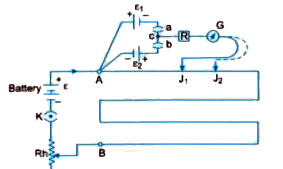The sensitivity of the potentiometer can be increased by
increasing the length of the wire
increasing the e.m.f. of the cell
decreasing the length of the wire
none of these
The correct Answer is:A
To solve the question regarding how to increase the sensitivity of a potentiometer, we will follow these steps:
1. Understanding Sensitivity:
- Sensitivity of a potentiometer refers to its ability to detect small changes in voltage. It is defined as the potential difference (voltage) per unit length of the potentiometer wire.
2. Defining Potential Gradient:
- The potential gradient (k) is defined as the potential difference (V) across the potentiometer wire divided by its length (L). Mathematically, it can be expressed as:
k=VL
- Here, V is the voltage applied across the potentiometer wire and L is the length of the wire.
3. Increasing Sensitivity:
- To increase the sensitivity of the potentiometer, we need to increase the potential gradient (k). This can be achieved by:
- Increasing the Voltage (V): By applying a higher voltage across the same length of wire, the potential gradient increases.
- Decreasing the Length (L): By using a shorter length of wire while keeping the voltage constant, the potential gradient also increases.
4. Practical Example:
- For example, if we have a potentiometer wire of 1 meter with a potential difference of 100 volts, the potential gradient would be:
k=100 volts1 meter=100 volts/meter
- If we increase the voltage to 200 volts while keeping the length the same, the new potential gradient becomes:
k=200 volts1 meter=200 volts/meter
- Alternatively, if we keep the voltage at 100 volts but reduce the length to 0.5 meters, the potential gradient would be:
k=100 volts0.5 meters=200 volts/meter
5. Conclusion:
- Therefore, the sensitivity of the potentiometer can be increased by either increasing the voltage applied across it or decreasing the length of the potentiometer wire.
- Sensitivity of a potentiometer refers to its ability to detect small changes in voltage. It is defined as the potential difference (voltage) per unit length of the potentiometer wire.
- The potential gradient (k) is defined as the potential difference (V) across the potentiometer wire divided by its length (L). Mathematically, it can be expressed as:
k=VL
- Here, V is the voltage applied across the potentiometer wire and L is the length of the wire.
- To increase the sensitivity of the potentiometer, we need to increase the potential gradient (k). This can be achieved by:
- Increasing the Voltage (V): By applying a higher voltage across the same length of wire, the potential gradient increases.
- Decreasing the Length (L): By using a shorter length of wire while keeping the voltage constant, the potential gradient also increases.
- For example, if we have a potentiometer wire of 1 meter with a potential difference of 100 volts, the potential gradient would be:
k=100 volts1 meter=100 volts/meter
- If we increase the voltage to 200 volts while keeping the length the same, the new potential gradient becomes:
k=200 volts1 meter=200 volts/meter
- Alternatively, if we keep the voltage at 100 volts but reduce the length to 0.5 meters, the potential gradient would be:
k=100 volts0.5 meters=200 volts/meter
- Therefore, the sensitivity of the potentiometer can be increased by either increasing the voltage applied across it or decreasing the length of the potentiometer wire.
Topper's Solved these Questions
- CURRENT ELECTRICITYBOOK - NIKITA PUBLICATIONCHAPTER - CURRENT ELECTRICITYEXERCISE - Multiple Choice Questions
314 Videos
- COMMUNICATION SYSTEMSBOOK - NIKITA PUBLICATIONCHAPTER - COMMUNICATION SYSTEMSEXERCISE - Multiple Choice Questions (Examples for Practice)
8 Videos
- ELASTICITYBOOK - NIKITA PUBLICATIONCHAPTER - ELASTICITYEXERCISE - MCQ
314 Videos
Similar Questions
Knowledge Check
Sensitivity of potentiometer can be increased by
AIncresing the e.m.f. of the cellBIncreasing the length of the potentiometer wireCDecreasing the length of the potentiometer wireDNone of the aboveThe sensitivity of a potentiom eter is increased b y
Aincreasing the emf of the cell.Bincreasing the length of the potentiometer wire.Cdecreasing the length of potentiometer wire.Dnone of the above.Sensitivity is the
AAbility to growBAbility to reproduceCAbility to detect changes in the environmentDAbility to capture sunlight
A student uses the circuit diagram of a potentiometer as shown in Fig.

(a) For a steady current I passing through the potentiometer wire, he gets a null point for the cell ε1and not for ε2 . Give reason for this observation and suggest how this difficulty can be resolved.
(b) What is the function of resistance R used in the circuit? How will the change in its value affect the null point ?
(c ) How can the sensitivity of the potentiometer be increased?
View SolutionState the principle of potentiometer. Draw a circuit diagram used to compare the emfs of two primary cells. Write the formula used. How can the sensitivity of a potentiometer be increased.
View SolutionThe potential gradient of a potentiometer can be increased by which of the following operation?
View SolutionWhy is a lactometer more sensitive than a normal hydrometer ? Explain how the sensitivity of a hydrometer can be increased.
View SolutionSensitivity is the
View Solution
